Visual Arts Review: The Supportive Imaginary — Weaves and Grids
By Helen Miller and Michael Strand
Grids come into these woven pieces with a strange humility, disarming us with repurposed materials and precious handiwork, domestic scenes, and visionary tales.
shape_shifting_support_systems, a group exhibition, co-organized by guest curators Leah Triplett Harrington and Mallory Ruymann, featuring seven contemporary artists working at the nexus of weaving, painting, and performance at the Praise Shadows Art Gallery, Brookline, through August 27.
Weaving is conventionally associated with tradition and craft, while grids are among the quintessential images of modernity. But between these two, as between the feminine and the masculine, the natural and the artificial, the historical and the contemporary, categories no longer mean what they used to. New relations between communities and the recognition of traditional forms of making and thinking undermine the distinction between weaves and grids. Weaving may even redeem the grid, providing a deeper understanding of what the form affords.
Embracing this change in perspective, the exhibition shape_shifting_support_systems features seven emerging artists whose work makes a case for the relevance of weaving in our time. In contrast to much contemporary art that, as co-curators Leah Triplett Harrington and Mallory Ruymann suggest, principally finds its value only in markets, weaving signifies a practice of care, intimacy, and support. This show explores a notable shift in what a “support system” can mean, both socially and aesthetically.
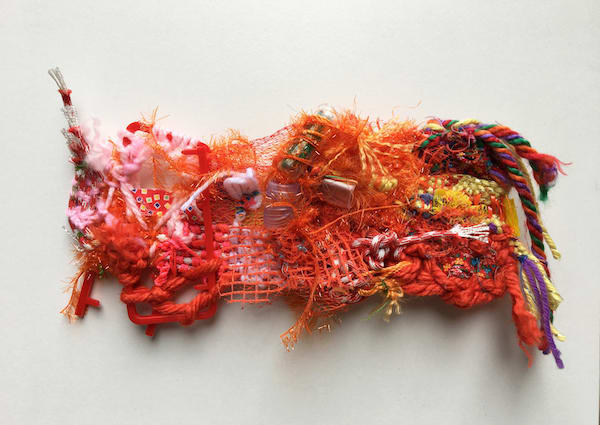
Loretta Park, Long Orange, 2020. Photo: Praise Shadows Art Gallery
Upon entering the gallery, we encounter seven small, colorful wall works by Loretta Park. Held together with acrylic yarn and all manner of thread, each celebration of parts and crafts is also a demonstration of weaving (even when buried fabric and half-finished lanyard bracelets, for example, remain more loosely attached). One piece hangs by an exposed loop of picture wire, another by a sparkling peek-a-boo screw. Park’s modest gathering achieves the kind of (formal, found) coherence that we might recognize seeing plastic floating in the ocean. Whatever our association, the works are of-a-piece, as if they like to be together, though we don’t exactly know why. Park has named Jessica Stockholder, Richard Tuttle, and Judy Pfaff as inspiration in her development as an artist and the criss-crossing of material properties, an exchange in which crochette can ooze and hot glue vividly holds its own. The use of color to order, or counter-order, objects, for which these artists are so well-known, is also in evidence. Park’s installation resonates tension, as the weaving assembles more by catching than connecting. Wrapping around scrappy plastic or painted cardboard, these pieces almost appear to drip.
Even if we don’t know why something holds together, we can still agree that it does. Park incorporates weaving into her work but it serves no centrifugal role; it’s not the source of strange attraction or the reason behind the concentrated patchwork web of Long Orange (2020) or Hidden Diamond (2022). A grid is not so much employed as picked up and added — in some cases we find mini grids of netting simply glued on. Humble material symbols, they suggest the possibility of order that the work ends up pursuing in its own way. Grids need not take over to impact or contribute to the overall function of a work of art. The implications of this demonstration are instructive, and moving, not unlike the prompts provided in an improvisational dance class.

Jeffrey Nowlin, Swine and Rabbit, 2020. Photo: Praise Shadows Art Gallery
Across the room, in Jeffrey Nowlin’s appropriately torso-sized biomorphic structures, the elements are tightly woven together in a manner that mimics the body’s own organic division of labor. Each piece of stretched clothing or stuffed fabric fulfills a function and finds a connection to all the others through a complicated network of internal piping, which surfaces at times anatomy-purple. It is not hard to find a reference to fluid dynamics in these works, a winding journey nicely self-contained. Neither do we see a grid in its entirety — it is an armature, a stretcher bar, however warped, protruding as a broken, bandaged bone. The grid is embedded. Order as interdependence reflects a taught dynamic in which the parts are not self-reflective; each simply does its job, or, falling short of that, remains along for the ride. For example, in Swine and Rabbit (2020) we find a bunny carefully tucked away about where an appendix would be. We do not want to ask this bunny any questions (“Why are you here?”) so much as wonder how it might inform us of the body’s function, or possible malfunction.
Bhen Alan’s weavings are similar in their refusal to leave anything out, or to leave any object or person — or aspect of personal history — at risk of being left out. Alan’s four carpet-sized wall panels contain highly gridded patterning along with a loosened knot and the curl of a ribbon. In places, the grid is all we can see, and it is durable enough to put to some purpose (shelter, protection, a place to rest), which is fitting considering the artist’s interests and background. Alan was born and raised in the Philippines and has since returned to teach art and research the tradition of woven baníg mats and baskets — which also tell the stories of their makers — and the resistance of informal economies to corporate neocolonialism.
The intact grid of Nanang (“Mother” in Filipino) (2022), a well-wrought weaving of recycled plastic tarp, comes apart in some panels, leaving an infrastructure clearly visible. It is as if it were missing important pieces. In other places, replacements have been found and woven into the matrix alongside the original strips of material. The result is motley but feels finished, ready for the stage; indeed, these panels started as stand-alone screens for a performance. In some cases, shiny fabrics and things one might associate with costumes or pageantry heighten the theatrical effect. Black plastic fans, bright fake feathers, rosaries, and rolled weavings stick out but never feel random. Jutting, draping, even dangling like a well-designed outfit, it all gets folded in.
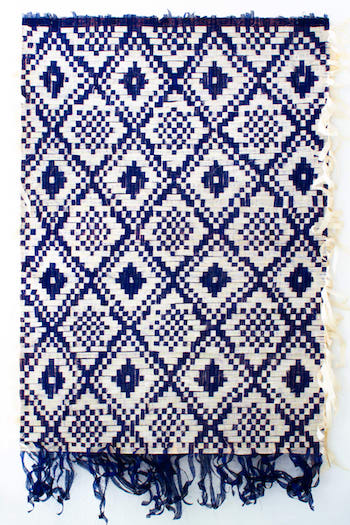
Bhen Alan, Nanang, 2022. Photo: Praise Shadows Art Gallery
Even when the grid is altered, retreats, or disintegrates, the confident, graphic composition persists as a kind of afterlife. Faint figures become visible, their hyphenated contours delicately stitched onto one tapestry. Camouflaged and ghostly, they appear at home, or at work, in the dense atmosphere of checkerboard weaving. It is not hard to discern a narrative across Alan’s weavings when you consider them together. Coexistence and resistance to disappearance become familiar, depending on the panel. While the work suggests a set or background, it also has its own story to tell. Alan fights off the frayed edge by confronting the challenge of weaving together difference rather than just repeating or varying the same pattern.
Stand Up Child (2022) by Emily Auchincloss has managed to fit into a placemat-sized weaving the sun (a piece of matte board, painted emoji yellow), the moon (another cut-out circle, shiny as a penny above the warp-and-weft of sky-and-sea), and the history of weaving and quilting up and down the East Coast, from Gee’s Bend to Black Mountain College. Auchincloss attended undergrad at the University of North Carolina and the work’s title — Stand Up Child — is spoken in a Southern vernacular that complements the work’s eye for color theory and its genealogy in contemporary and 20th-century American art. A former rower, Auchincloss’s weaving references various schools of European and New England painting through its engagement with perceptual play and improvisation. The lineage of German textile artist Anni Albers and others like Trude Guermonprez, who made the women’s work of weaving into a respected and free form of aesthetic expression in the West, is immediately apparent, but equally felt are household names or museum figures like Wassily Kandinsky, Paul Klee, Joan Miró, and Albert Pinkham Ryder, the romantic “painter’s painter” from New York.

Emily Auchincloss, Stand Up Child, 2022. Photo: Praise Shadows Art Gallery
Auchincloss sews thumbnail weavings onto her woven scrolls, which further call up the constructivist collage of Kurt Schwitters and Ella Bergmann-Michel, contemporary artist Claudia Wieser’s drawing installations, and the print-laden paintings of Tomashi Jackson (local Boston media maverick), whose breaking-open of material and conceptual subjects alike seems to have influenced this exhibition as a whole. Auchincloss’s apparent joy in the history of anti-perspective suggests the perceptual possibilities of a cross-cultural grid — a mother grid, if you will. Are they mandalas, color wheels, or targets, a central motif in the work of Pop Art icon Jasper Johns, or practice for thinking about the threatened state of learning, floating above and below the inlaid ruglike barriers in Moon Rocks (2022)?
In contrast to celestial spheres and abstract bodies — the dance of light and limb — we are then presented with a kinetic sensibility that reflects digital media software and the surface of water. With the size and dimension of a monitor one might expect to encounter in a group show, Courtney Stock’s Euphotic Zone (2022) is in fact an analog mix of egg tempera, gouache, and acrylic paint boldly if sensitively applied with a broad brush and sponge on woven paper, which is embroidered with the outline of a few simple shapes. Stock here manages something otherworldly, the opposite of natural, though the piece evokes an artist famously inspired by plant life, namely Ellsworth Kelly, and his arrangements “by chance” from the ’50s. If Kelly cut his chance explorations into paper with scissors to achieve something resembling digitization avant la lettre, Stock takes digital inspiration from her education as an artist both on the computer and in the studio. And what a good student she is. There are no ripped edges or loose ends here. The cuts are clean, almost sanitized, but also rhythmical, the opposite of static. Stock achieves a digital feel, not by simply printing out a Photoshop document but by using imagination, allowing the grid inside the screen more bandwidth and enabling her artwork to float, thanks in part to an elegant behind-the-scenes steel support. Is there an equivalent to weaving in Photoshop? Stock leads us to ask this question through the digital craftsmanship her analog schema follows through into another, more robust dimension.
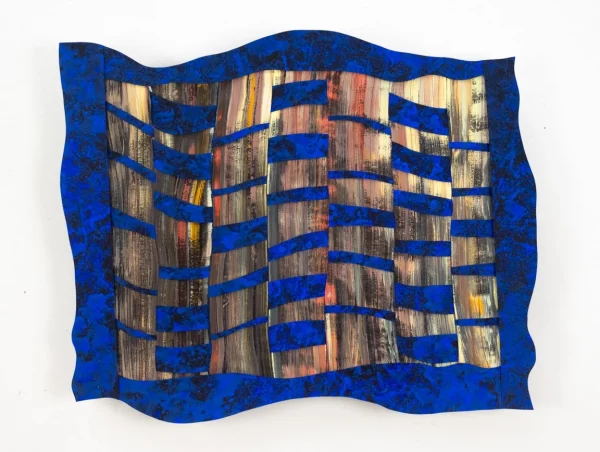
Courtney Stock, Euphotic Zone, 2022. Photo: Praise Shadows Art Gallery
Similar nuance is achieved in Denise Treizman’s six weavings, which echo portrait painting, with its themes of preservation and decay. DayGlo, glitter, and actual lights mix with grids in varying stages of deterioration. Holes and Gold (2020) features a weblike shroud covering a glitterish gold panel. Though not as far along in their demise, the tattered tinsel weave of Sparks (1) and Sparks (2) (2021) are similarly structured, like framed paintings, and Untitled (Wrapping Grid) (2022) seduces us with its surface adornment of taped neon tubing, an unwieldy weave. When grids collapse how do we perceive their end? As farce or tragedy? Or perhaps as spectacle? Like dying stars, most brilliant as their chemical compounds unravel, these pieces conceal and reveal intense interiors.
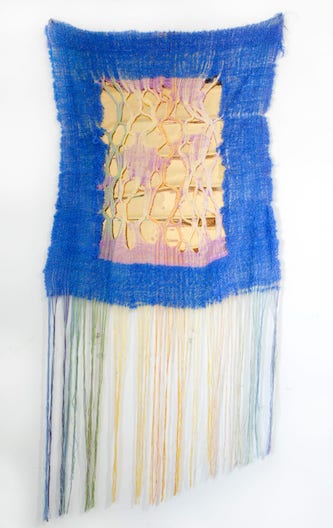
Denise Treizman, Holes and Gold (2020). Photo: Praise Shadows Art Gallery
Behind the wall of the main space, we find Natiana Alexandra Fonseca’s practice weavings and practice grids. On an even smaller scale, these works originated as prototypes or tests, pushing forward bold ideas. Fonseca discovers essential principles about her materials: how stiff, how inclined to wave or overlap, what each will do if left long. Chicken Feathers (2020), a fuchsia pink and purple weaving with a compellingly taut, bumpy texture, is partially covered by a foot of black strands cut at intervals extending toward the floor. The visually striking image brings to mind the undercut hairstyle popular among Gen-Z; the blush of sunset in the underlying woven mat supplies added appeal. In Mammatus Clouds (No. 3) (2020) the grid is caught and pulled — it expands and bubbles up — creating a distorted visual and topography. Grids can bend and curve, Fonseca shows us, and they can be used to bond or bridge two sides, as in the intricate strings reaching out and winding together Mammatus Clouds (No. 1) (2020). Eva Hesse’s papier-mâché, wire mesh, and rubber “test pieces” and cloudy late grid drawings come to mind. Like Hesse’s experiments, Fonseca’s are sensuous, thought-provoking explorations of the potential of grids to fold, sag, and stand on end. Fonseca’s work demonstrates that grids are by no means homogenous, even in the hands of a single practitioner.
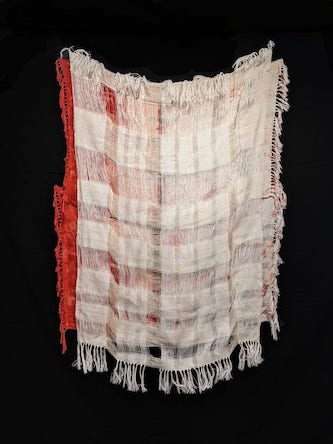
Natiana Alexandra Fonseca, Introducing Manuel Carreira Dos Santos Fonseca, 2022. Photo: Praise Shadows Art Gallery
With the knowledge that her smaller works were made to investigate material form, we can still imagine them as excerpts or windows onto a larger narrative, and indeed the larger, layered shroudlike creation on the adjacent wall has a story to tell. Introducing Manuel Carreira Dos Santos Fonseca (2021), which the artist describes as an alternative approach to a family tree, is made up of almost imperceptibly distinct sections of delicate linen, cotton, and silk, one third soaked and wiped in red, which represent figures in Fonseca’s Angolan ancestry, a complicated bloodline that runs through the violence and poverty of colonization into revolution and national independence. The sophisticated use of material and form to visualize so much trauma is a testament to the artist and the range of affect that can be woven into a grid artfully and experimentally rendered.
20 years ago, the materials and objects that appear in this show would have been simply juxtaposed, loosely connected, or casually stacked, more assemblage than grid. Now they are woven together, at least in places, and sometimes obsessively. What might this development teach us? This show signals a redemption of weaving or, building on that gesture, a redemption of grids through weaves. Grids come into these pieces with a strange humility, disarming us with repurposed materials and precious handiwork, domestic scenes, and visionary tales. Eminently crafty, the weaves on display are approachable; you can sit with them. They make the grids accessible and rekindle the imagination about what support systems can look like.
Helen Miller is an artist. She teaches at the Massachusetts College of Art and Design and Harvard Summer School. Michael Strand is a professor in Sociology at Brandeis University.

[…] Visual Arts Review: The Supportive Imaginary — Weaves and Grids artsfuse.org Article Source […]